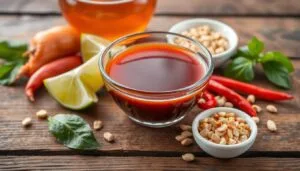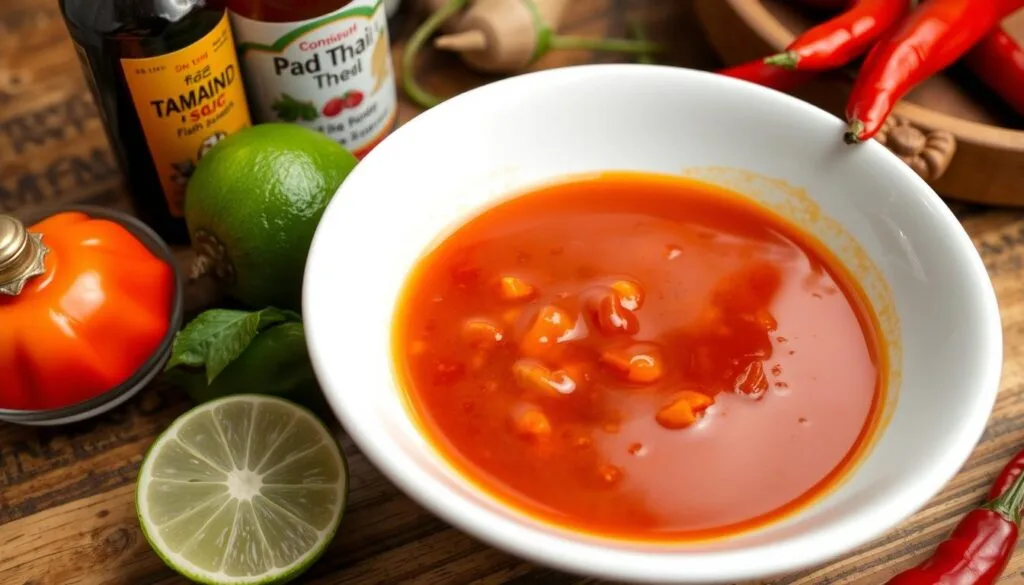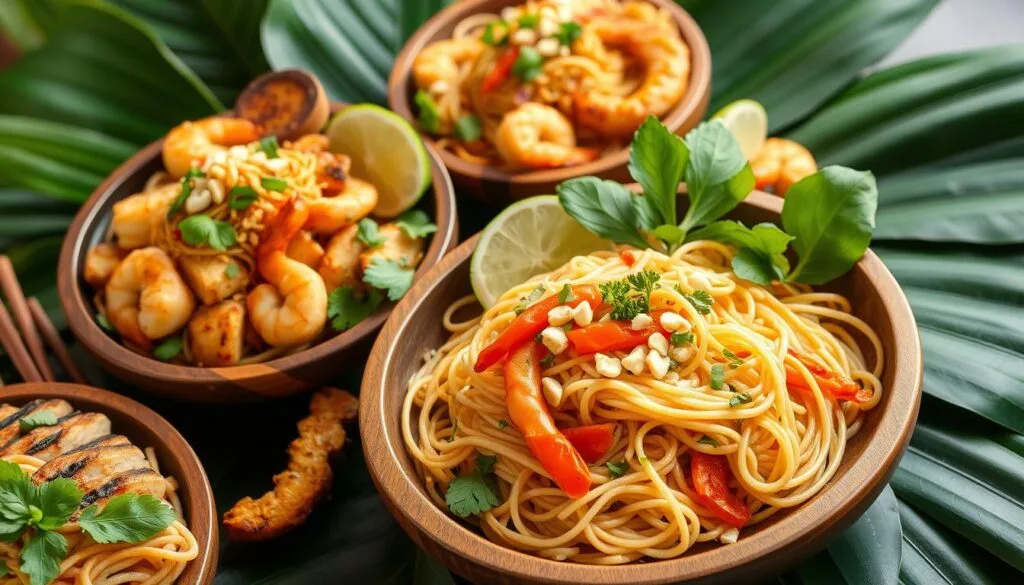The Best Fluffy Pancakes recipe you will fall in love with. Full of tips and tricks to help you make the best pancakes.

I’ve always been fascinated by the flavors of Thai cuisine. The first time I tried Pad Thai, it felt like a trip to Bangkok’s street markets. The smell of noodles and the mix of sweet, sour, salty, and spicy flavors amazed me. Now, I’m excited to share how to make a great Pad Thai sauce that will take you to Thailand.
Key Takeaways
- Discover the essential flavor profiles that define authentic Pad Thai sauce.
- Understand the role of tamarind and fish sauce in achieving the perfect balance.
- Learn the step-by-step method for preparing a professional-grade Pad Thai sauce.
- Explore tips for customizing the heat and sweetness to suit your personal preference.s
- Discover common mistakes to avoid for a consistently delicious Pad Thai experience.
Understanding Traditional Thai Sauce Components
Authentic Asian recipes like Pad Thai need a mix of sweet, sour, salty, and spicy flavors. This mix is made with ingredients that have been used for centuries in Thai cooking.
Essential Flavor Profiles: Sweet, Sour, Salty, and Spicy
Sweetness in Thai stir-fry sauces comes from palm sugar or brown sugar. They add a caramelized taste. Sourness is from tamarind paste, a tangy fruit concentrate. Saltiness comes from fish sauce, which is umami-rich and adds depth.
The Role of Tamarind in Authentic Thai Cooking
Tamarind paste is key in traditional Thai sauces. It gives a tart and tangy flavor. This ingredient has been used for centuries, making Pad Thai taste authentic.
Fish Sauce and Umami Elements
Fish sauce, or nam pla, is vital in Thai cooking. It adds a savory, umami-rich taste. Though it has a strong smell, it’s used carefully to make Thai stir-fry sauces unique.
“The true essence of Thai cuisine lies in the harmonious balance of these four primary taste sensations.”
Key Ingredients for Perfect Pad Thai Sauce Recipe
Making a real Pad Thai sauce needs a mix of key ingredients. These ingredients create the sweet, sour, and savory tastes that make Pad Thai special. Fish sauce, rice vinegar, and palm sugar are the main trio that makes the sauce perfect.
Fish sauce gives the sauce its deep umami flavor and saltiness. Rice vinegar adds a tangy, bright taste that balances the sweetness. Palm sugar, or brown sugar, adds a sweet, caramel-like flavor that holds the sauce together.
Peanut butter is often added for creaminess and a nutty taste. It makes the sauce smooth and helps balance the strong flavors.
Sriracha or dried shrimp powder can also be used to add more flavor. They bring heat and umami, enhancing the sauce’s taste. The goal is to mix these ingredients just right to get the perfect sweet, sour, salty, and spicy mix.
“The secret to a great Pad Thai sauce lies in the careful selection and precise blending of its key components – from the savory fish sauce to the bright rice vinegar and the rich, caramelized palm sugar.”
With the right mix of these ingredients, you can make Pad Thai sauce at home. It will bring the flavors of Thailand right to your kitchen.
The Secret Behind Restaurant-Style Thai Flavors
The secret to Thai cuisine and Asian recipes is balancing flavors. Chefs use top-notch fish sauce and fresh tamarind pulp for authentic pad Thai sauces.
Balancing Traditional Taste Elements
A great pad Thai sauce has sweet, sour, salty, and spicy notes. Chefs tweak sweetness and acidity to fit local tastes or their own. They make sure the sauce sticks to the noodles right.
Professional Tips for Sauce Consistency
Getting the pad Thai sauce right is key. Chefs mix chicken stock and fish sauce for a sauce that clings well. They add a bit of chili sauce or cayenne pepper for a hint of heat, balancing the flavors.
“The secret to the best pad thai sauce lies in the perfect balance of sweet, sour, salty, and spicy flavors, achieved through the thoughtful selection and proportion of ingredients.”
By learning from chefs, home cooks can make restaurant-style Thai flavors at home. With practice and focus, anyone can master Asian recipe making.
Step-by-Step Sauce Preparation Method
Making the perfect pad Thai sauce recipe is key to getting authentic Thai flavors at home. Let’s go through the steps to make this essential sauce. It will make your stir-fry sauces even better.
Begin by dissolving 2 oz of tamarind pulp in 1/2 cup of boiling water. Strain the mix through a fine-mesh sieve. This removes pulp or seeds, keeping the flavorful tamarind liquid.
In a small saucepan, mix the tamarind liquid with 3 Tbsp of grated palm sugar, 2 Tbsp of fish sauce, and 1 Tbsp of Thai black soy sauce. Heat it over medium, stirring now and then. This ensures the sugar dissolves and the sauce becomes smooth.
Try the sauce and adjust the flavors if needed. You might want to add a bit of Sriracha or Thai chili sauce for more spice.
After adjusting the flavors, take the sauce off the heat. Let it cool down to room temperature before using it in your pad thai. This method guarantees a top-notch pad Thai sauce recipe that will delight your taste buds.
Customizing Your Sauce’s Heat and Sweetness
Making authentic Thai cuisine at home is fun because you can change the flavors to your liking. Adjusting the spice and sweetness in your Pad Thai sauce can make it even better.
Adjusting Spice Levels
For a milder sauce, use less Sriracha or other chili sauces. Start with a small amount, taste, and add more spice if needed. If you want it spicier, add more of these Asian recipe ingredients.
Sugar Alternatives and Sweetness Balance
- Palm sugar is traditional in Thai cuisine and adds a caramel-like sweetness. But you can also use light brown sugar, honey, or maple syrup.
- Begin with a small amount of sweetener and add more until the flavors are balanced. Too sweet can ruin the dish.
Customizing your Pad Thai sauce’s heat and sweetness is all about trying different things. Experiment and find the perfect mix of flavors that excites your taste buds. This way, you can make a Thai cuisine dish that’s truly yours.
Storage Tips and Shelf Life
Homemade pad Thai sauce recipe is a great addition to your Thai cooking. But, it’s important to store it right to keep it fresh and tasty. Here’s how to keep your pad thai sauce at its best:
For short-term storage, keep your pad Thai sauce in an airtight container in the fridge for up to a week. This keeps the sauce’s flavors bright and stops it from drying out or going bad. Make sure the container is tightly closed to keep it fresh.
To make your pad Thai sauce last longer, freeze it. Pour the sauce into ice cube trays and freeze. Then, pop out the sauce cubes and store them in an airtight bag or container in the freezer. This method can keep your sauce good for 2-3 months.
When you want to use frozen pad Thai sauce cubes, thaw them in the fridge overnight. Always check the sauce for any signs of spoilage before using. For the best taste and safety, use your pad Thai sauce within 3-4 days of making it.

| Storage Method | Shelf Life |
|---|---|
| Refrigerator | Up to 1 week |
| Freezer | 2-3 months |
By following these easy storage tips, you can enjoy your homemade pad Thai sauce for weeks. Happy cooking!
Common Mistakes to Avoid When Making Thai Sauce
Making an authentic Thai sauce is a delicate task. Even a small mistake can ruin the balance of flavors. To make your homemade Thai cuisine taste like restaurant quality, avoid these common mistakes.
Temperature Control Guidelines
Temperature is key when making Thai sauce. If you overcook it, the sauce can taste bitter. So, use low to medium heat to avoid burning the sauce.
Ingredient Substitution Rules
- Don’t swap regular soy sauce for fish sauce. Soy sauce lacks the unique umami that fish sauce adds to stir-fry sauces.
- Rice vinegar can substitute for tamarind, but it won’t give the same rich flavor.
- For sweetness, use palm sugar or honey. White sugar can make the sauce too sweet.
Follow these tips and use traditional Thai ingredients. You’ll make a sauce that’s full of flavor. It will take you straight to Bangkok’s lively streets.
Pairing Your Sauce with Noodles and Proteins
Take your noodle dishes to the next level by pairing them with the right ingredients. Choose rice noodles that are just right, not too hard or too soft. They should soak up the flavors well. For protein, go for shrimp, chicken, or tofu for the best taste.
Start by adding the sauce to your stir-fry little by little. This way, the noodles get coated evenly and the flavors mix perfectly. Feel free to add bean sprouts, peanuts, and chives for extra texture and taste. Finish it off with a squeeze of lime juice for a burst of freshness.
| Ingredient | Nutritional Information (per serving) |
|---|---|
| Boneless Skinless Chicken Breasts (1 lb.) | Calories: 395, Fat: 15g, Carbs: 34g, Protein: 28g |
| Pad Thai Dish (1 serving) | Calories: 627, Carbohydrates: 77g, Protein: 22g, Fat: 27g |
This Pad Thai sauce has a 4.97 out of 5 rating from over 5,000 votes. It’s a game-changer for your noodle dishes and Asian recipes. It’s quick to make in just 30 minutes and brings the taste of Thai street food right to your kitchen.

“The key to a perfect Pad Thai is in the balance of flavors – the sweet, the sour, the salty, and the spicy. This sauce recipe nails it every time.”
Conclusion
Making your own Pad Thai sauce lets you enjoy top-notch Thai cuisine right at home. You can tweak the sauce to fit your taste by balancing sweet, sour, salty, and spicy flavors. This way, you keep the true taste of Thai cooking while making it your own.
With a bit of practice, you’ll get better at making this sauce. Once you nail the Pad Thai sauce recipe, your homemade Pad Thai will taste amazing. You’ll bring the lively flavors of Thailand right to your kitchen.
Learning to make authentic Pad Thai sauce is a fun journey. It lets you dive into the rich culture of Thai food. As you get better, you’ll want to try more of Thai cooking’s wonders.









